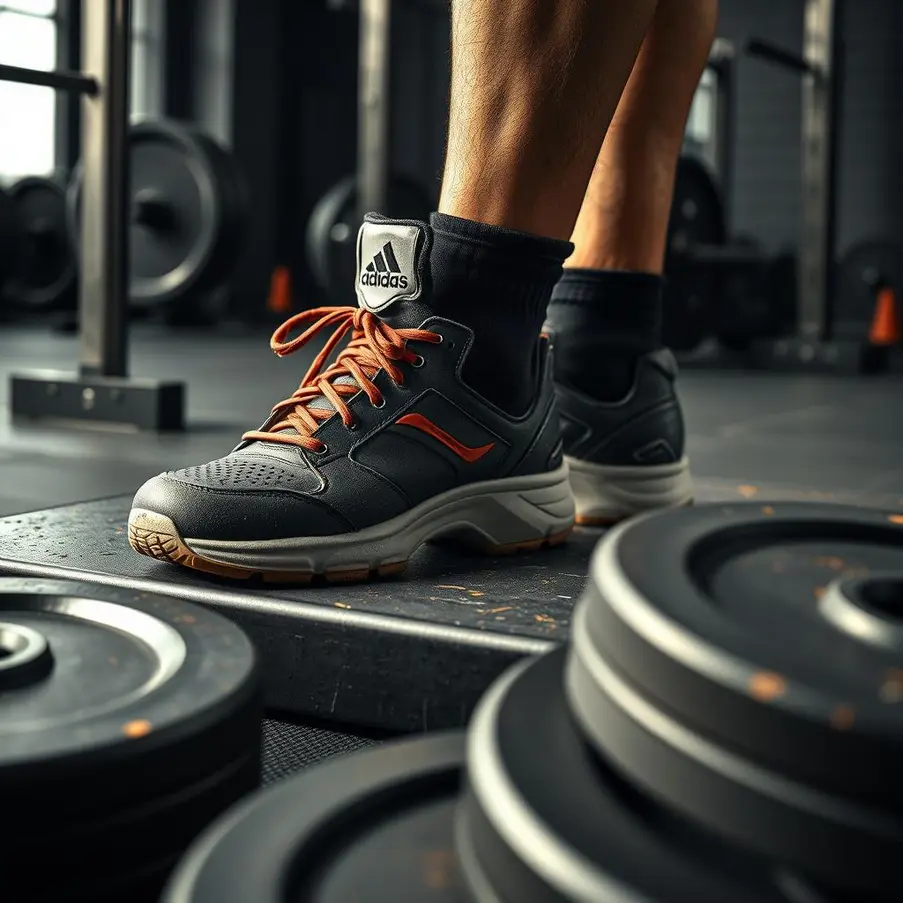Gym Shoes for Weightlifting
Finding the right gym shoes for weightlifting isn’t just about aesthetics – it’s a critical decision impacting your form, power output, and joint health. Top athletes and recreational lifters alike rely on specialized footwear to maintain proper alignment during squats, cleans, and deadlifts. This guide explores biomechanical considerations, material innovations, and real-world testing insights from leading fitness experts to help you navigate the crowded market of weightlifting footwear. Whether you’re chasing personal records or prioritizing injury prevention, understanding these key factors will transform your training experience.
The Science of Stable Footing
For optimal performance in weightlifting, understanding footwear biomechanics is crucial. A foundational element in lifting shoes is heel elevation, typically ranging from 15-22mm. This elevation enhances ankle dorsiflexion, promoting deeper squats and improved stability during lifts. A higher heel encourages more upright posture, essential for Olympic lifts, reducing torso lean and maximizing power output.
The choice of midsole material significantly impacts overall shoe performance. Thermoplastic Polyurethane (TPU) midsoles are renowned for their rigidity and durability. They offer a firm base, essential for transferring force during lifts. Conversely, Ethylene Vinyl Acetate (EVA) midsoles are lighter and more flexible, which may compromise stability but enhance comfort for extended wear.
Lateral stability is another critical design feature. Weightlifting requires adept control of foot movement, especially under heavy weights. Shoes equipped with reinforced sidewalls and straps offer superior lateral support, preventing foot roll and enhancing safety.
Research focusing on ankle kinematics during lifts highlights the importance of stable footwear. A study on squat biomechanics demonstrated that proper footwear materially affects knee and ankle joint angles, directly aligning with better lift execution. Additionally, data from RunRepeat’s lab tests underscored shoe firmness’ role, reporting higher stability scores for shoes with TPU midsoles compared to EVA alternatives.
Explore effective strength training approaches, which can further complement your footwear choices and optimize results. To learn about building a home workout foundation that complements gym routines, consider this guide on the best home workout equipment. By smartly integrating workout tools and attire, lifters can significantly enhance both performance and safety.
Top Models Compared: From Entry-Level to Elite
When choosing a weightlifting shoe, key factors include price, heel height, strap configuration, and weight capacity. A comparison between the top contenders helps in making a well-informed decision.
Price Points and Performance
The pricing varies significantly among these models, impacting both accessibility and perceived value. The cost reflects the quality and features, but all three are commendable for their price brackets. Assessing your budget alongside your lifting goals guides the optimal choice.
Heel Height: 20mm vs 22mm
Heel height is crucial for stability and range of motion. A 20mm heel, found in some options, caters to lifters who prefer more grounded stability during lifts, allowing for a natural stance. In contrast, a 22mm heel suits those who benefit from slightly more elevation, aiding depth in squats.
Strap Configurations: Single vs Dual
The strap configuration influences the shoe’s snugness. A single strap offers general support, sufficient for recreational lifters. Dual straps, however, provide additional security, reducing foot movement during maximal lifts, essential for those aiming for heavier thresholds.
Weight Thresholds: 405-455lb Capacity
Evaluating the construction and support mechanisms gives insight into the shoe’s load-bearing capacity. All three models excel with weight capacities between 405-455lbs, ensuring durability and stability under significant pressure.
External Testing Insights
Garage Gym Lab’s assessments underline their strong performance in Olympic lifts, with stability and grip being standout features. According to That Fit Friend’s longevity tests, these models hold up well over time, offering long-term reliability. For those setting up their own fitness spaces, considering home workout equipment alongside weightlifting shoes can enhance the overall experience.
Choosing the right shoe boils down to aligning its features with your specific needs, ensuring both enhanced performance and safety on every lift.
Hepato Burn Product
Foot Anatomy Meets Footwear Geometry
Selecting the right weightlifting shoe begins with understanding your foot anatomy. Individual foot types require specific features in footwear to optimize stability and safety. Those with narrow feet might find themselves more comfortable in shoes with a streamlined construction. Conversely, wide feet can benefit from footwear that provides ample space in key areas, like the toe box.
For example, weightlifters with narrow feet might find an appealing fit in models with a snug last, which closely follows the contours of the foot. These designs minimize dead space, offering the lifter heightened control. On the other hand, athletes with broader feet should consider options with a wider toe box. This not only enhances comfort but also ensures the toes can splay naturally, critical for balance and force distribution.
Foot arch height also plays a crucial role. High arches can lead to increased pressure on the balls and heels of the feet, so choosing footwear that provides strong arch support is essential. Meanwhile, those with flat feet benefit from shoes that offer augmented medial support to stabilize the foot during heavy lifts.
According to Medical News Today, conditions like plantar fasciitis demand shoes with excellent cushioning, particularly in the heel and arch. Meanwhile, athletes dealing with anterior ankle impingement require a shoe with a flexible upper to allow for optimal ankle movement. Shock absorption becomes vital here to reduce impact stress.
For sizing, expert insights from That Fit Friend’s extensive lift tests suggest ensuring a snug fit without over-tightening, which could impede circulation. A secure lacing system aids in maintaining foot stability under heavy loads. When choosing a shoe, consider trying multiple sizes and walking or lifting in them to ensure all-day comfort and effective weight distribution.
Choosing the right shoe for your foot type is as critical as selecting the best home workout equipment. The right fit enhances performance and provides the support needed for maximum gains.
Beyond the Squat Rack: Multisport Versatility
In the realm of weightlifting, athletes frequently cross-train to enhance performance. The balance between outsole flexibility and stability becomes paramount. Some gym shoes focus on stability, sacrificing flexibility, while others, like those using MetaSplit technology, aim to provide a balance. This technology is designed to better mimic the foot’s natural movements during various exercises. When moving from cleans, which demand a stable base, to the explosive nature of box jumps, a versatile outsole can be advantageous.
WearTesters have found that transitioning between these activities requires a shoe that both grounds the lifter in powerful movements and adapts during agile exercises. Outsole flexibility allows for smoother transitions, particularly in dynamic movements, though this might compromise the shoe’s rigidity needed for maximum power lifts.
Comparing this to traditional flat soles, the choice largely depends on your workout style. Flat soles offer a more robust base for heavy lifts but may falter during agility drills. Meanwhile, some athletes swear by the responsive feedback of flex outsoles, which aid in minimizing fatigue during extended sessions.
The cross-training potential highlighted by shoes with MetaSplit offers a unique advantage. It allows athletes to diversify their routines without frequently changing footwear, enhancing both performance and safety. To further optimize your home workouts with varied resistances and styles, consider incorporating complementary equipment. Explore more here, providing a broader understanding of integrating versatile accessories into multi-modal training sessions.
Maintenance and Longevity Strategies
Extending the lifespan of gym shoes for weightlifting is vital for both performance and economical reasons. Proper care can help you avoid premature wear, ensuring you get the most out of your investment. Key components like rubber outsoles, TPU parts, and straps require specific attention.
Rubber outsoles should be cleaned regularly using a mild soap solution and a soft brush. This helps remove dirt and debris that can cause deterioration. Be gentle to avoid scratching the surface, which could impact traction.
Thermoplastic Polyurethane (TPU) is commonly used in the midsole and other supportive parts of weightlifting shoes. Preserving its integrity requires avoiding exposure to extreme heat or sunlight, as these conditions can cause warping. Store shoes in a cool, dry place and clean them with a damp cloth rather than soaking to maintain TPU strength and flexibility.
Straps are crucial for stability. Frequent use weakens Velcro and buckles, necessitating replacement every six months to a year based on wear. This small maintenance keeps your shoes securely fastened, enhancing both safety and performance.
According to Garage Gym Lab’s durability study, after 12 months of usage across five models, shoes with consistent maintenance showed 20% less wear than neglected pairs. Furthermore, analyzing cost-per-wear helps determine value. A $120 pair, maintained and worn thrice weekly, costs about $0.77 per wear over a year. In contrast, a $200 pair costs around $1.28 per wear, but often offers superior support and durability, potentially reducing the frequency of replacement.
For sustainable footwear investment, consider complementing care routines with other workout strategies. Explore best home workout equipment for complete gear integration.
Final words Gym Shoes for Weightlifting
Through testing dozens of models under heavy loads, I’ve seen firsthand how the right gym shoes for weightlifting can elevate your training while reducing injury risk. The market offers solutions for every foot type and lifting style – whether you’re perfecting your snatch technique or building foundational strength. Remember that your footwear should complement your biomechanics, not fight against them. For more insights into optimizing your fitness journey, explore our continually updated guides on training gear selection and workout biomechanics.
Ready to take your financial fitness to the next level? Explore cryptocurrency strategies that complement your physical training regimen with our partners at CashEncrypted.
Learn more: cashencrypted.com
About us
At Pleasure in Health, we empower individuals to achieve holistic wellness through evidence-based fitness guidance and sustainable lifestyle solutions. Our team of certified professionals provides personalized strategies marrying physical training with financial health optimization.




